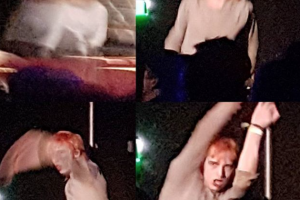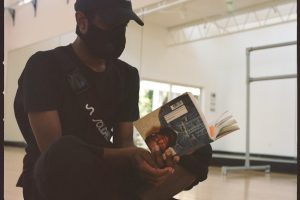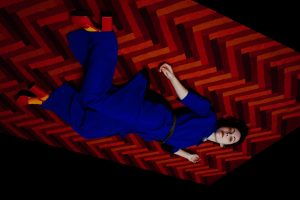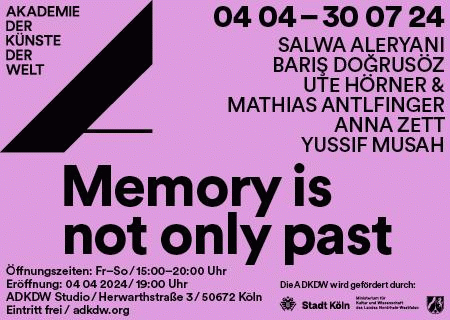HEAVY CALMNESS – AN INTERVIEW WITH KMRU
SOUND ARTIST KMRU AKA JOSEPH KAMARU TOOK THE TIME TO TALK ABOUT HIS RELATIONSHIP WITH INSTALLATIONS, FOLLOWING HIS PARTICIPATION IN “OCEANIC REFRACTIONS” AT CTM FESTIVAL 2024, AND HOW HIS PRAXIS OF FIELD RECORDING HAS BEEN SHIFTING THROUGH EMANCIPATORY NOTIONS OF CALMNESS. WE MET ON A DECIDEDLY RAINY MONDAY IN A COFFEE SHOP SOUNDSCAPE OF REIMAGINED 80S POP SONGS.
INTERVIEW: SAMUEL OBERNOSTERER, PHOTOGRAPHY: PHILIPPE GERLACH
Just having experienced an installation you worked on, I was interested in how your artistic praxis might change when producing for installations because there are so many explicit para-materials to guide the listener.
When I moved to Berlin and started doing my master’s degree in ‘Sound Studies and Sonic Arts’, I tried to expand on my field, and installations were something I was very curious to explore. I enjoy that the artwork just lives on its own and can be experienced without you being there. In an extended way, I still try to relate installations to performance. I have a very specific relationship with installations. I have done solo performances that were already very site-specific regarding the speakers and the space. You know: Multichannel pieces that are specific and can be experienced in a short duration. So, my performances are already often very particular, but you experience them, and then it is done. Installations are sustained by many different people, but the piece is experienced on its own.
It’s an attempt to be more inviting?
If you are working with some sort of multi-channel setup, then it’s always work that is specific to the place. However, most venues and spaces don’t have this, so you then have to look for different nuances in the piece that translate to a stereophonic image or a headphone piece. That’s the beauty of installations, you can scale everything up, into sound walls, but it works the same with visuals or text. I’ve done installations with different people, the one at CTM recently was one of them. Just last year, I was involved with architects for a project at the Architecture Triennal in Sharjah. I made some recordings there and then created a piece for cave bureau’s Anthropocene Museum, it’s a very different approach as I was involved in the work from the beginning. Of course, there is some exclusivity about who can experience an installation, but it is still nice that it can live on its own and was exhibited for five months.
A site-specific piece is often designed to induce calmness. Calmness is a word that’s often associated with your work, and I would be interested in what calmness means for you, because it’s so ambivalent for me. It’s something for which I am searching, yet sometimes it feels like a reclusion to some notion of the private; I am shutting myself down.
Yeah, I understand what you mean, calmness, or even silence. Sometimes an audience is silent, and you feel like you are in a calm state, and there’s some sense of grounding. But there comes a point when you are calm, yet you are on the edge. Calm and anxious, or you feel something is wrong. In this specific piece at CTM I mentioned, “Oceanic Refractions“, [which deals with oral histories, the ocean, and ecocide and displacement as a consequence of colonial-capitalist violence] you get so calm that it becomes uncomfortable, that’s where the potential of calmness lies. It’s something that I try in music, sometimes it can be calming and soothing yet there is a heaviness that comes with it.
I think you cannot be calm all the time. People say that I am a very calm person, and you could associate that with my music, but sometimes I try to transform this calmness into a heavy physical force, it is calm yet heavy. Especially for this last piece, yes, it is calming, but when you stop to think about the stances of the piece, it is decidedly un-calm. I like bridging these nuances in your mind.
I heard you say previously that “some things shouldn’t be recorded”, which really stuck with me, especially with the “Oceanic Refractions” installation, because with field recording comes this notion of making something audible, rearranging a hierarchy, but the framework of capturing a moment can also be subjugating.
When I started field recording, I approached the praxis in a very naïve way. I was just recording for the sake of it. More and more places that I used to go to record, like neighbourhoods where I didn’t actually know anyone, started to feel uncomfortable, even in Nairobi. Sometimes you feel unease about having a device that captures, documents or stores. It is something I was thinking more and more about — why am I even recording? So, when I am in spaces where I don’t feel I should record, I started to just listen. The reasons for this can also be more trivial: you forget your SD-Card and can just sit down and listen. Maybe that’s what the environment wants me to do, just engage with a place with my ear, slowing down.
Even during my shows, I just want to listen and create a mood that invites people to do the same. It’s been a while, but now I am fully getting back into it. I haven’t moved again since moving to Berlin and really started to feel grounded in my neighbourhood in Moabit where I recorded a lot. In the end, I really got back into field recording when I worked with Elvin Brandhi last year.
Last year you also released “Dissolution Grip” on your new imprint OFNOT. What’s the plan for your label?
It was triggered by my coursework at school, where so many works and different projects were created, and I needed a channel for that. I’ve been thinking about the label for two years, and I also want to release artists I feel connected to. I’ve been getting requests. I also write and take images, so this can be a space to put out different formats alongside music. With Dissolution Grip, I was looking at field recordings from a synthesis point of view, recordings done specifically with this goal in mind. The field recordings are used as a framework, to guide the synthesis.
I was assuming you were working with a lot of field recordings on “Dissolution Grip”, but they sort of took a step back; it felt more synthesized. For me, the album is such a culmination of “Peel and Limen”, the EP you did together with Aho Ssan.
Aho Ssan was the one who made me dive deeper into synthesis. I had the idea of making something close to Peel but not Peel, so it’s funny that you mention it. There’s this track, “Till Hurricane Bisect”, which was the first track I made for this project, that is all about loops that cross into each other. The synthesis side of the track comes with ideas of intensity, like distortion and saturation, but on the edge, which could come from working on Limen. Field recordings are still the grounding of the project. Using the field recordings more as a score…
Do you write scores or (graphic) notation for your works?
I used to write notation for field recordings, but sometimes instead of actually recording I will draw a score of what I am listening to. Finding different ways of recording. Scores are interesting as I am very visual – most of the artworks are pictures I have taken. Dissolution Grip has graphic notation, as it came from a school project, it has a very detailed score, taking it into a spectrogram.
Is there some music that’s really engaging you at the moment?
Maybe I can mention that I have a pen pal situation with someone I met at a show in the US two years ago, and this guy turned out to be Lana Del Rey’s guitarist. We’ve been talking ever since, and his solo stuff is so different; it’s so beautiful. He’s called Blake. We’ve worked on stuff together, sharing sounds and plugins, and trying to collaborate. Yesterday I played a DJ-Set on Cashmere Radio in Berlin with my friend Ross Alexander, and I went into this SoundCloud hole of weird dubby sounds. This sort of ambient/pop/dub stuff which is interesting sound-design wise and also just really enjoyable to listen to. But it’s good to be back in Berlin, I am bubbling with energy, I haven’t produced or performed since last November.
What have your thoughts on listening been?
Different people approach listening based on how they culturally grew up, and for me at home, I feel like listening is something you grew up with. It wasn’t told that you should sit down and listen – it was more implicit. Something I’ve mentioned in a talk before is that the ear in Swahili is called ‘sikio’ which comes from the word ‘to listen’, sikiza. There’s no separation between listening and the ear, even agreeing on something, ‘skizana’, it’s still connected to the ear. When you listen together, you can agree on something. It feels very connected to how the culture of listening is, it’s never verbalized, but it is inherent to how people listen.
The ear connection is really interesting. It highlights the materiality of sound in your body and the world.
Trying to attune to a specific place is like beatmatching, matching your ear to the city you are in, you familiarize yourself with the environment, and if something strikes you as new, it could be a nuisance, but you could also allow it. I appreciate this openness, maybe it comes from the original naiveness of my field recording praxis. I didn’t know that there was this history of isolating sounds, trying to get rid of airplanes passing above, for example. I didn’t have these rules or ideas about a good recording sounding a certain way. I recorded my body being present while holding the field recorder.
Do you relate this to people looking for something unmediated?
I think this idea of having a really pristine sound, removing the environment, is not what field recording is about. It’s not about capturing a specific sound. It’s about allowing the body and the environment to be part of the recording.
I enjoy recording on my old iPhone. The microphone is terrible, and it highlights the translation.
I am thinking about silence again — different ways of silence. You mentioned calmness, for “Oceanic Refractions” at Silent Green we were thinking about intentional silence, without forcing it. I don’t have a clear thought, but it is about being comfortable with a silence that provokes. Sometimes there is this intentionally forced silence, barring people from speaking out. That’s not what I am talking about. We allow silence that can be appreciated; something that can be appreciated without having to be vocalised. It’s still a very abstract thought.
Every time you say it out loud it will form.
[silence]
Maybe we can end in that silence.
 “This article is brought to you by Struma+Iodine as part of the EM GUIDE project – an initiative dedicated to empowering independent music magazines and strengthen the underground music scene in Europe. Read more about the project at emgui.de”
“This article is brought to you by Struma+Iodine as part of the EM GUIDE project – an initiative dedicated to empowering independent music magazines and strengthen the underground music scene in Europe. Read more about the project at emgui.de”
Funded by the European Union. Views and opinions expressed are however those of the author(s) only and do not necessarily reflect those of the European Union or the European Education and Culture Executive Agency (EACEA). Neither the European Union nor EACEA can be held responsible for them.















